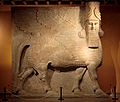Shedu
From Wikipedia, the free encyclopedia
|
|
This article has multiple issues. Please help improve the article or discuss these issues on the talk page.
|
The Sumerian word lama, which in Akkadian is translated as lamassu, refers to a helpful and protective female god. The corresponding male god was called alad, in Akkadian, šêdu (cf. Hebrew שד šed).[1]. Also known as an urmahlullu.
In art they were depicted as hybrids, as winged bulls or lions with the head of a human male (Centauroid). There are still surviving figures of šêdu in bas-relief and some statues in museums. Notable examples of šêdu/lamassu held by museums include those at the British Museum, Musée du Louvre, National Museum of Iraq, Metropolitan Museum of Art and one extremely large example kept at the Oriental Institute, Chicago. They are generally attributed to the ancient Assyrians.[2] [3]
To protect houses the shedu were engraved in clay tablets, which were buried under the door's threshold[citation needed]. At the entrance of palaces often placed as a pair. At the entrance of cities they were sculpted in colossal size, and placed as a pair, one at each side of the door of the city, that generally had doors in the surrounding wall, each one looking towards one of the cardinal points[citation needed].
Contents |
[edit] Shedu (Lamassu)
The Shedu is a celestial being from Mesopotamian mythology. He is a human above the waist and a bull below the waist. He also has the horns and the ears of a bull.
It appears frequently in Mesopotamian art, sometimes with wings. Statues of the bull-man were often used as gatekeepers.[citation needed]
[edit] Shedu and Lammasu in fiction
Lammasu and Shedu are two distinct types of good-aligned creatures in the role-playing game Dungeons & Dragons. Lammasu also appear in the Magic: The Gathering trading card game as the white card Hunted Lammasu in the Ravnica: City of Guilds expansion.
A bull with a man's head is found among the creatures that make up Aslan's army in The Lion, the Witch and the Wardrobe. He appears at the Stone Table, challenging the White Witch "with a great bellowing voice". In the film Alexander, Lamassu are seen at the Ishtar Gate in Babylon.
In the Disney movie Aladdin, a gold Lamassu can be found in the scene where Aladdin and Abu enter the cave in the desert to find the lamp.
[edit] Gallery
|
|
This section looks like an image gallery. Wikipedia policy discourages galleries of random images of the article subject; please edit or remove the section accordingly, moving freely licensed images to Wikimedia Commons if not already hosted there. |
British Museum Collection
|
The British Museum - Human Headed Winged Lions and Reliefs from Nimrud with the Gates of Balawat |
The British Museum - Human Headed Winged Bulls from Khorsabad |
The British Museum - Human Headed Winged Lion and Bull from Nimrud, companion pieces in Metropolitan Museum of Art |
The British Museum - Assyrian Sculpture, notice the colossal Lion Lamassu |
Musée du Louvre Collection
|
Musée du Louvre - Human Headed Winged Bulls from Khorsabad, otherwise known as Lamassu's |
Musée du Louvre - Human Headed Winged Bulls, Sculpture and Reliefs from Khorsabad, note the Lamassu in the foreground is a cast from the Oriental Institute, Chicago |
Musée du Louvre - Human Headed Winged Bulls and Reliefs from Khorsabad |
Musée du Louvre - Human Headed Winged Bulls and Reliefs from Khorsabad |
Metropolitan Museum of Art Collection
|
The Metropolitan Museum of Art - Human Headed Winged Lion and Bull from Nimrud, companion pieces in the British Museum |
Oriental Institute of the University of Chicago Collection
[edit] Winged lion in Venice
In a much later period, a winged lion appeared on the flag of the Republic of Venice; however, this refers to Saint Mark the Evangelist, the patron saint of Venice.
[edit] See also
[edit] References
- ^ An illustrated dictionary, Gods, Demons and Symbols of Ancient Mesopotamia. (2003; Jeremy Black and Anthony Green, The British Museum Press; ISBN 0-7141-1705-6)
- ^ BBC - History - Mesopotamia
- ^ Lamassu - Ancient Near East.net
[edit] External links
| Wikimedia Commons has media related to: Shedu |












